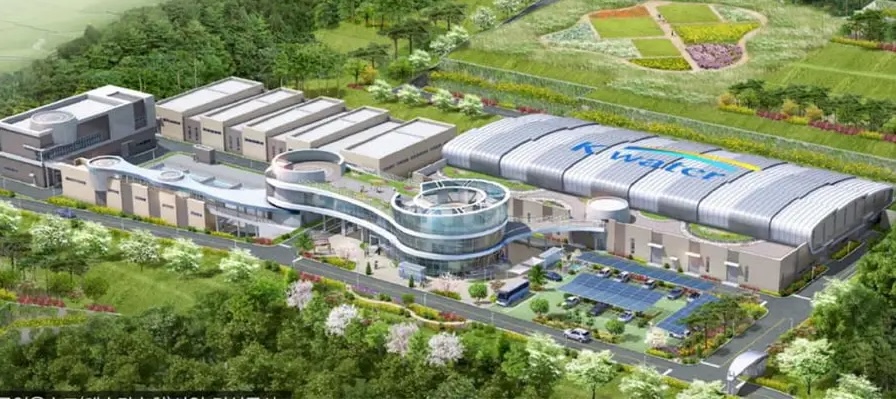
Direct air capture technology is suffering from an identity crisis. Drawing excess carbon from the air can simply enable fossil energy stakeholders to make up the difference, empowering them to dig up more carbon from the ground and spew it into the air. On the bright side, though, direct air capture can be deployed to help resolve other pressing issues, and water resource conservation is one of them
Direct Air Capture And The Capture6 Solution
The water treatment angle first came across the CleanTechnica radar last year, when the US startup Capture6 reached out to share their latest news.
The company is planning to showcase its direct air capture technology under the title Project Monarch (we’ll get to Project Octopus in a second), in a demonstration project with the Palmdale Water District in California.
Capture6’s technology will be integrated into the PWD’s forthcoming Pure Water Antelope Valley water recovery plant, which is a story unto itself. The $15 million demonstration-scale plant is expected to break ground around the middle of 2024. It will be the precursor to a full scale, high tech wastewater recovery and public education project with an estimated price tag of $75 million to $100 million.
“When the full-scale facility is operational 2027, it will provide an additional 5,325 acre-feet of water per year by using recycled water and treating it for groundwater augmentation,” PWB explains. “The treatment would remove 99.99% of bacteria, viruses and ions (like salt).
Salt is where Capture6 comes in. The company’s direct air capture technology is deploys salt to capture carbon and squeeze more usable water from treatment plants, which otherwise would be disposed of in the form of a salty waste brine.
In a press release last June, Capture6 cited a spokesperson for PWD who anticipates that its direct air capture system will eliminate brine discharges from the plant, while saving 30-40% on water treatment costs.
The State Of The Technology
There is not much of a mystery behind conventional direct air capture systems. As explained by the US Department of Energy, there are two basic kinds, and they are both expensive.
“The downside to direct air capture is its current cost. Removing CO2 from the air takes lots of power because only a tiny percentage of the atmosphere is made up of CO2. The technology also involves costs to store or use the captured CO2,” the Energy Department explains.
The more familiar kind of direct air capture system sucks air through a process that involves chemical solvents, heat, and a vacuum, after which the carbon-reduced air is released back to, well, the air. The chemicals are recycled back into the process, but the heat and vacuum stages require energy, where the costs kick in.
The alternative is a sorbent-based system, which deploys filters that chemically bind with carbon dioxide. That’s about the extent of the difference between the two systems, because sorbent systems also require heat and vacuum treatments. “When the filters are heated and/or placed under a vacuum, they release the CO2, which is now in a concentrated stream,” the Energy Department explains.
The Capture6 Difference
Capture6 provides a money-saving workaround by linking its technology with water treatment systems. They kindly emailed some additional technical details to CleanTechnica that clarify the difference.
“The process involves splitting salt in brine waste through electrochemical processes, producing a base and an acid,” they explain. “The base absorbs CO2 from the air, forming carbonates for long-term storage.”
That’s not quite the same thing as carbonite, but the basic idea is the same. Carbonates are the main ingredient in solid materials like seashells and limestone. Once locked into a carbonate, the airborne carbon can be put to use instead of being shunted underground.
Among the money-saving features noted by Capture6, the process conserves water resources by producing fresh water from wastewater. In addition to a potential revenue stream from that source, the system also harvests valuable chemicals including lithium, hydrogen, and hydrochloric acid, which is the stuff in your stomach that dissolves food.
The system also operates at energy-efficient, ambient temperatures, providing more opportunities to use renewable energy as a power source.
“The technology is versatile, allowing various input and output configurations, and it integrates synergistically with multiple industries,” Capture6 adds.
Jumping Direct Air Capture Up To Scale
Capture6’s describes its direct air capture system as cutting-edge, but the company also emphasizes that the system consists of elements with a firmly grounded history in relevant technologies and a supply chain, to boot. In other words, the system is ripe for scale-up.
“For example, the water treatment step uses reverse osmosis; nanofiltration is routinely used in the desalination industry; the electrochemical splitting uses decade-old electrolysis technology or electrodialysis which is recently gaining traction; the air contactors are an extension of cooling towers used widely in power generation and other industrial facilities,” Capture6 explains.
Capture6 is adding some further tweaks to those air contactors, with a leg up from the two Energy Department offices that are providing a cash grant and technical help through the agency’s Direct Air Capture Pre-Commercial Technology Prize. The company expects to reduce total energy demand by up to 15% as a result of the assist.
The Octopus Project And The Energy-Water-Air Nexus
Even before the Antelope Valley project gets off the ground, Capture6 has already embarked on its next demonstration project. Called Project Octopus, the system will be installed as part of a new water treatment facility in Korea billed as “the world’s first fully integrated water management and carbon dioxide (CO₂) removal facility using a seawater desalination plant.”
The Project Octopus direct air capture system will be scaled up in two phases. Once fully built out, Capture6 expects it to remove up to 500,000 metric tons of carbon dioxide every year.
The project pairs Capture6 with the Korean state-owned water utility K-water and the water treatment specialist BKT. The overall purpose of the new treatment system is to deliver usable water to the Daesan Industrial Complex, where about 40% of South Korea’s petrochemical production is located, without further stressing the region’s already drought-stressed freshwater resources.
“The region has been suffering from water scarcity due to severe droughts and reliance on external water resources,” Capture6 notes.
“By partnering with water treatment facilities like the one K-water is building, Capture6’s technology can provide affordable carbon removal while increasing the facility’s freshwater yields,” Capture6 notes. The technology will also help reduce the environmental impacts of disposing desalination brine into the ocean.
The petrochemical industry angle takes some of the green sizzle off the sustainability shine, but as Capture6 points out, its direct air capture system provides an alternative supply chain for some of those petrochemicals
“The company’s process will also generate green chemicals to further decarbonize K-water’s water management operations and heavy industries such as steelmaking,” Capture6 adds.
If all goes according to plan, Project Octopus will not be the only one of its kind for long. K-water chairs the Asia Water Council, described as “the representative global water platform for addressing Asia’s water issues and enhancing water welfare of the region,” with 152 organizations from 24 countries as members.
Image: Rendering of the planned K-water treatment plant in Korea featuring a new direct air capture system from the US startup Capture6 (courtesy of Capture6).
Have a tip for CleanTechnica? Want to advertise? Want to suggest a guest for our CleanTech Talk podcast? Contact us here.
Our Latest EVObsession Video
[embedded content]I don't like paywalls. You don't like paywalls. Who likes paywalls? Here at CleanTechnica, we implemented a limited paywall for a while, but it always felt wrong — and it was always tough to decide what we should put behind there. In theory, your most exclusive and best content goes behind a paywall. But then fewer people read it!! So, we've decided to completely nix paywalls here at CleanTechnica. But...
Thank you!
Advertisement
CleanTechnica uses affiliate links. See our policy here.
- SEO Powered Content & PR Distribution. Get Amplified Today.
- PlatoData.Network Vertical Generative Ai. Empower Yourself. Access Here.
- PlatoAiStream. Web3 Intelligence. Knowledge Amplified. Access Here.
- PlatoESG. Carbon, CleanTech, Energy, Environment, Solar, Waste Management. Access Here.
- PlatoHealth. Biotech and Clinical Trials Intelligence. Access Here.
- Source: https://cleantechnica.com/2024/01/16/direct-air-capture-water-treatment-octopus-project-korea/
- :has
- :is
- :not
- :where
- $100 million
- $UP
- 000
- 15%
- 152
- 2024
- 24
- 36
- 500
- a
- About
- absorbs
- According
- across
- adding
- addition
- Additional
- addressing
- Adds
- Advertise
- Affiliate
- affordable
- After
- AIR
- All
- Allowing
- already
- also
- alternative
- always
- Ambient
- an
- and
- anticipates
- ARE
- around
- AS
- asia
- Asia’s
- assist
- At
- Atmosphere
- back
- Bacteria
- base
- basic
- BE
- because
- been
- before
- behind
- being
- BEST
- between
- bind
- Bit
- both
- Break
- Bright
- Building
- built
- but
- by
- california
- called
- came
- CAN
- capture
- captured
- carbon
- carbon dioxide
- Cash
- chain
- chemical
- chemicals
- chip
- cited
- cleantech
- Cleantech Talk
- co2
- combines
- comes
- Companies
- company
- Company’s
- completely
- complex
- Concentrated
- CONSERVATION
- consists
- content
- conventional
- Cost
- Costs
- Council
- countries
- crisis
- Current
- cutting-edge
- decarbonize
- decide
- decided
- deliver
- Demand
- Department
- Department of Energy
- deployed
- deploys
- described
- describes
- details
- difference
- DIG
- direct
- district
- don
- downside
- drawing
- due
- Education
- elements
- eliminate
- embarked
- embedded
- emphasizes
- empowering
- enable
- energy
- enhancing
- environmental
- estimated
- Every
- example
- excess
- Exclusive
- expected
- expects
- expensive
- Explain
- explained
- Explains
- extension
- extent
- external
- facilities
- Facility
- familiar
- Features
- Featuring
- felt
- fewer
- filters
- firmly
- First
- food
- For
- form
- forthcoming
- fossil
- fresh
- from
- full
- full-scale
- fully
- further
- gaining
- generate
- generation
- get
- Global
- Goes
- grant
- Green
- Ground
- Guest
- heavy
- help
- here
- High
- history
- HTTPS
- hydrogen
- idea
- Identity
- if
- Impacts
- implemented
- in
- In other
- Including
- increasing
- industrial
- industries
- industry
- ingredient
- input
- instead
- integrated
- Integrates
- into
- involves
- issues
- IT
- ITS
- itself
- jpg
- june
- kick
- Kind
- korea
- Korea’s
- Korean
- Last
- Last Year
- latest
- Latest News
- like
- likes
- Limited
- linking
- links
- lithium
- located
- locked
- Long
- long-term
- lots
- made
- Main
- make
- management
- materials
- Media
- Members
- metric
- Middle
- million
- money-saving
- more
- most
- much
- multiple
- Mystery
- Need
- New
- news
- next
- noted
- Notes
- now
- ocean
- of
- off
- offices
- on
- once
- ONE
- only
- operates
- operational
- Operations
- opportunities
- or
- organizations
- Osmosis
- Other
- otherwise
- our
- out
- output
- overall
- pairs
- part
- partnering
- People
- per
- percentage
- phases
- placed
- plan
- planned
- planning
- plant
- plants
- platform
- plato
- Plato Data Intelligence
- PlatoData
- player
- podcast
- points
- policy
- potential
- power
- precursor
- press
- Press Release
- pressing
- price
- process
- processes
- producing
- Production
- project
- provide
- provides
- providing
- public
- publish
- purpose
- put
- quite
- radar
- reached
- Read
- Reader
- recently
- recovery
- recycled
- reduce
- region
- release
- released
- relevant
- reliance
- removal
- remove
- rendering
- Renewable
- renewable energy
- representative
- require
- resolve
- resource
- Resources
- result
- revenue
- reverse
- routinely
- salt
- same
- saving
- Scale
- scale-up
- Scarcity
- Second
- see
- severe
- Share
- shine
- should
- showcase
- side
- simply
- So
- solid
- some
- Source
- South
- specialist
- spokesperson
- Squeeze
- stages
- stakeholders
- startup
- State
- state-owned
- Step
- storage
- store
- Stories
- Story
- stream
- such
- suffering
- suggest
- supply
- supply chain
- support
- Sustainability
- system
- Systems
- T
- TAG
- takes
- Talk
- team
- tech
- Technical
- Technologies
- Technology
- that
- The
- their
- Them
- then
- theory
- There.
- they
- thing
- those
- though?
- Through
- tip
- Title
- to
- tons
- Total
- tough
- traction
- treating
- treatment
- treatments
- tweaks
- two
- under
- Updates
- us
- usable
- use
- used
- uses
- using
- utility
- Vacuum
- Valley
- Valuable
- various
- Ve
- versatile
- Video
- viruses
- want
- was
- Waste
- Water
- we
- Welfare
- WELL
- What
- when
- which
- while
- WHO
- widely
- will
- with
- without
- words
- world’s
- would
- write
- Wrong
- year
- yields
- you
- Your
- youtube
- zephyrnet








